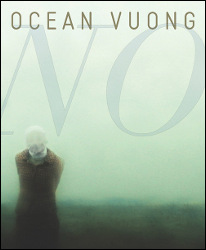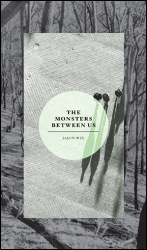|
by Emily Chow
 
Ocean Vuong, No, YesYes Books, 2013. 40 pgs.
Jason Wee, The Monsters between Us, Math Paper Press, 2013. 95 pgs. Both Ocean Vuong and Jason Wee are in relatively early stages in their poetry careers. No is Vuong's second collection, and The Monsters between Us is Wee's debut. Although Vuong's collection is very much about the US whereas Wee's focuses on Singapore, the two books share thematic concerns. If one puts the titles of the poems in the two collections side by side, it does not take long for her to realise that the majority consists of seemingly trivial subjects, such as "air," "mirror," "summer" and "blizzard" (in Vuong's collection) and "Grimm Tales," "oranges," "crab" and "boat" (in Wee's). Yet neither collection is interested in exploring the presumed beauty of these objects. Instead, they offer substantial portrayals of the mundane, and transform apparently insignificant moments into images that glow with perplexity and sometimes pain. No begins with a haiku by Marsuo Bashō's (1644–1694): "On a journey, ill: / my dream goes wandering / over withered fields." It sets the stage for the entire collection, as the motif of a "dream" over "withered fields" recurs throughout No. In fact, "some words reflected in the mirror," begins with a dream: i want to find a gun / and change myself / he said/ in the dream only a week before his mother called
[…]
vandross on the stereo muted tv / the room pink / with images of a bloody dictator / my face the shade of strawberry icing / as i sit through one war / after another hold the page closer / to the glass dammit / imagine yourself in / real life/ there should be tears / there should be / a reason but all i have / is the voice: 17 children are gunned down in Afghanistan Writing the poem in free verse without punctuation or a conventional line-structure allows the imagery to flow in an effortless manner. It also helps underline the fact that war and violence are not entirely detached from daily life in the US—the singer Luther Vandross and the "bloody dictator" appear on the very same television screen; the pink colour of the room and the "strawberry icing" echo the bloodiness of the dictator. Transient echoes of violence can indeed be found in the mundane. The scattered lines in "american dreams" provide a more personal perspective on the country's recent military engagements and painfully unveils the persona's disillusionment with her American dream: We made it. We’re riding in the back of the black limousine. They have lined the road to shout our names. [...] They have a good citizen in me. I love my country. I pretend nothing is wrong [...] I’m not really Jackie-O & there isn’t a hole in your head, a brief Rainbow through a mist of rust. I love my country but who am I kidding? I’m holding your brains in, darling. My sweet, sweet Jack. The persona hints that her husband was a soldier killed in a war, and she is probably at his funeral. By alternating the lines between left and right, Vuong creates empty space and projects a sense of solitude. The interchanging lines also embody the dialogue taking place inside the persona's mind, as she tries to persuade herself that even though her husband is dead, she is still patriotic. Yet, she remains conscious that she is only pretending. Here, the dream falls apart and reveals itself to be a "slaughterhouse." One of the reasons Vuong is such a promising poet is his tactful use of free verse. The packed, run-on lines of "some words reflected in the mirror" and the echoing lines in "american dreams" are good examples. Through these works and others in the collection, Vuong offers a seamless picture that synthesises everyday life with warfare and violence. If one were to offer a synopsis of the collection, the very first line of "and then the blizzard" might suffice: "Hope is a feathered thing / that dies / in the Lord's mouth." The dream is no longer a utopia charged with hopes; it is the dystopia of "withered fields." Compared with No, Wee's The Monsters between Us is relatively more light-hearted. At the very beginning of the collection, the tale of Hansel and Gretel is transformed with features of modern Singaporean life: If Hansel and Gretel lived here
[...]
the gingerbread house tempts them because
it is air-conditioned and the witch
serves iced everything – coffee less sugar
to Milo dinosaur and pearled tea. ["Grimm's Tales"] In Wee's version of the fairy tale, the greatest temptation for children in modern Singapore is not candy but the desire to cool off, and the witch tempts with the comfort of an air-conditioned room and popular iced-drinks like "Milo Dinosaur" and "pearled tea." As in the original, however, the differentiation between good and evil is still defined by temperature as the witch tries to "cook" the children, only this time in a very contemporary way—"The children knew she was evil when / they caught her with the air-con remote / secretly turning up the thermostat." Such a transformation of the well-known tale is amusing, especially to those familiar with Singapore's climate. The tone in other parts of the collection is more serious. "Unreliable evidence," for example, which marks the second setion of the book, takes a turn towards the political. It begins with Letter to Gianmarco by the philosopher Antonio Negri: I don't agree with your invitation to return to the truth. What truth?
Such a return inevitably has to be ambiguous. What exactly is it,
this truth of art? What we have here is only the truth of man-
made – the truth of that which is constructed and which seems to us
to constitute a new portion of being. "The truth" is one of the key themes in this section, which mainly focuses on how facts and reality are presented within the context of Singapore's history and politics. The majority of the poems are connected with actual historical events, but the most enthralling portion is probably Part III of "1987." The words deployed in this part resemble those from a newspaper. Yet, they are rearranged carefully: On 21 May , the Department
arrested persons involved in
the
existing political , using
tactics to establish a state.
Part of the plan was lawful
including religious bodies, and
actions
leading to
_____
Investigations. This use of line indentation to present factual material is intriguing. Wee explains this technique (which he also uses in Parts II and V of "1987") in "Notes" at the end of the collection: "Many poems in the 'Unreliable Evidence' sequence are composed from redacted official documents, the line breaks representing redacted parts of texts." Adapting official documents and transforming them into poetry is a brilliant way to mock the artificiality and fragmentation of "the truth" offered by the Singaporean government. By underlining the fluidity of language, "the truth" is transformed from a stable signifier to an unreliable monster which can freely undergo metamorphosis. Vuong's and Wee's poetry captures an overwhelming sense of the strangeness and confusion they see in everyday life. Although Vuong is concerned with violence and absurdity in the US while Wee focuses social phenomena in Singapore, they are both spectacularly creative in arranging lines and stanzas. Such cautious structuring of lines enhances and intensifies the moods, tones and themes they explore in their work—which is, after all, what successful poetry is all about. |